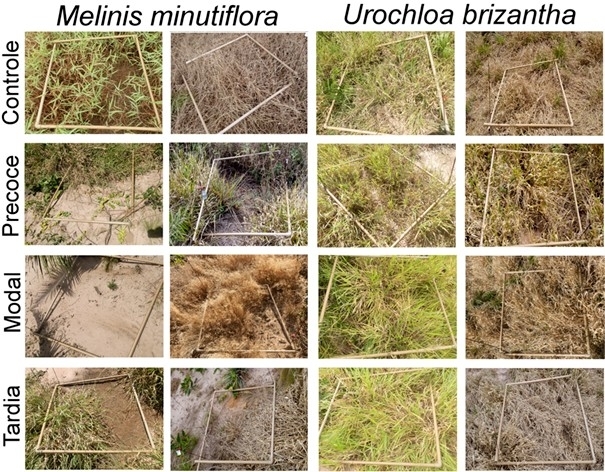


Communities initially invaded by Melinis minutiflora (left-hand columns) and Urochloa brizantha (right-hand columns). Photographs taken after two years of burn experiment, showing unburned control plots (top row); early burn (in May, second row); modal burn (in July, third row); and late burn (in September, bottom row). In communities dominated by each invasive species, the first and second columns represent samples for the rainy and dry season respectively (photos: Gabriella Da
Published on 03/18/2021
By José Tadeu Arantes | Agência FAPESP – The Cerrado, the predominant biome on Brazil’s Central Plateau, is the most biodiverse savanna in the world, with 35 different plant species per square meter. Some of Brazil’s most important rivers rise in the Cerrado, including the Xingu, Tocantins, Araguaia, São Francisco, Parnaíba, Gurupi, Jequitinhonha, Paraná and Paraguay, among others. Its survival is dramatically threatened by expansion of the agricultural frontier and inadequate land management.
Invasive species are doing serious damage to the Cerrado, especially signalgrass and other African grasses of the genus Urochloa, introduced to Brazil for cattle pasture and capable of propagating from cultivated areas into conservation areas and wildernesses, where they trigger changes in native plant communities and reduce the occurrence of endangered species with precious medicinal properties, such as Erythroxylum vaccinifolium (catuaba) or Brosimum gaudichaudii (mama-cadela), for example.
The use of fire as a land management technique, and in particular whether it can control or at least reduce the occurrence of these invasive species in conservation units, was investigated in a study conducted during the master’s research of Gabriella Damasceno, now a PhD candidate, under the supervision of Alessandra Fidelis at São Paulo State University’s Bioscience Institute (IB-UNESP) in Rio Claro, Brazil. The study was supported by FAPESP via a Young Investigator Grant awarded to Fidelis and a master’s scholarship awarded to Damasceno. A paper describing the study is published in the Journal of Environmental Management.
“Our aim was to measure the extent to which the timing of fires in the Cerrado – whether they occur in the early, middle or late dry season – affects the abundance of Melinis minutiflora [molasses grass] and Urochloa brizantha [palisade grass]. These are invasive species found in several conservation units in the Cerrado,” Damasceno told Agência FAPESP. “Also, because the predicted effects of climate change on the Cerrado include an increase in the frequency of extreme events such as drought and outlier temperature highs and lows, we wanted to see if rainfall and temperature ranges influence the recovery of these two invasive grasses.”
The results showed opposite responses to the use of fire for land management purposes, with the abundance of M. minutiflora being reduced by burning in all parts of the dry season and U. brizantha not being affected at all compared with unburned controls.
“The study also produced an unexpected result: when M. minutiflora was eliminated by fire, U. brizantha invaded the burned area more easily. Burning at the start and end of the dry season controlled the former but also accelerated a fresh invasion by the latter,” Fidelis said.
The two invasive grasses were also differently influenced by environmental variables. The greater the precipitation (rainfall), the more one was replaced by the other. The abundance of M. minutiflora correlated negatively with the amount of rainfall (i.e. an increase in rainfall reduced its total and dead biomass), and vice-versa for U. brizantha. Colder temperatures were harmful to both species but in different ways, with the former’s abundance decreasing and the latter’s dead biomass increasing.
“Our findings show that in future it will be more challenging still to control invasive grasses in the Cerrado, since even similar species respond so differently to land management initiatives,” Damasceno said. “Moreover, combined responses by two or more invasive species may be hard to predict, given the variable influence of environmental factors on the response of each species.”
The article “Abundance of invasive grasses is dependent on fire regime and climatic conditions in tropical savannas” can be retrieved from: www.sciencedirect.com/science/article/pii/S0301479720309440?via%3Dihub.
Source: https://agencia.fapesp.br/34247